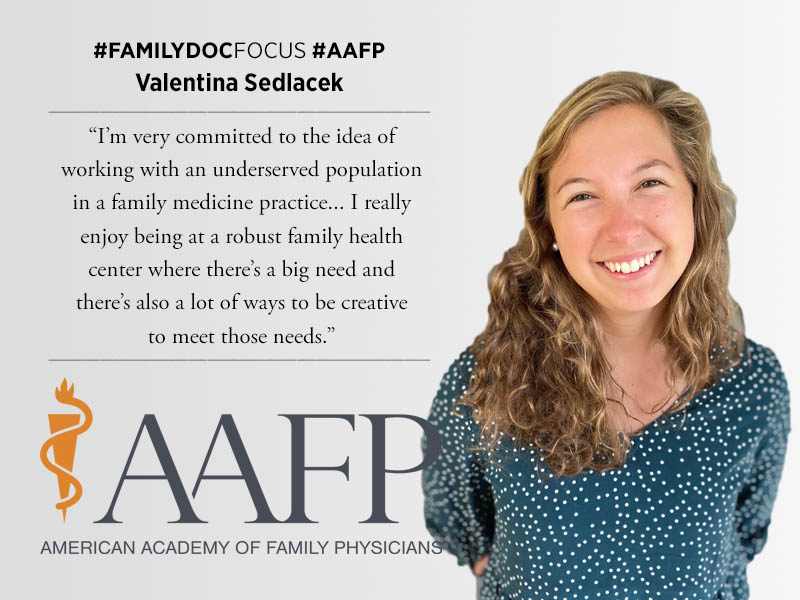Medical Student Finding Ways to Connect with Patients, Peers
August 30, 2021, 3:35 p.m. David Mitchell — A child of immigrants, Valentina Sedlacek grew up with a German father and a Chilean mother. Given a choice of five elective pathways at the University of Rochester School of Medicine and Dentistry, Sedlacek opted for the path that required her to learn yet another language.

Rochester, N.Y., has one of the nation’s largest per capita populations of people who are deaf, so Sedlacek opted to focus on deaf health. That pathway requires students to learn medical sign language and American Sign Language and complete a related research project.
“It was another way to communicate with patients that I was seeing in the clinic and hospital,” Sedlacek said. “My family has always spoken multiple languages, and being able to communicate in the same language as your doctor is something that I’ve seen is incredibly important. A lot of patients who are deaf don’t have a good connection with primary care and have low health literacy because they’re not absorbing the everyday talk about health-related topics. If I’m going into health care, whether that be in Rochester or another place, this could be a really important skill to have to be able to actually communicate with my patients in a way that makes them feel comfortable.”
Communication also factored in Sedlacek’s initial interest in family medicine. During an undergraduate internship at the Greater Lawrence Family Health Center in Lawrence, Mass., she was impressed by the relationships between family physicians and their patients.
“I have an anthropology background, and so it meant a lot to me that doctors actually talked and listened to their patients and knew what was going on in a way that I hadn’t seen in any other discipline,” she said. “I loved the continuity of care and that every hour was something different. It felt like family medicine doctors could actually make a difference, and the projects that I was working on with those physicians were in response to the challenges patients were bringing them.”
Sedlacek said the questions an anthropologist researches and attempts to answer should be beneficial to the population of interest and based on its needs. That aligns with what she hopes to do in family medicine.
“Family physicians do that pretty much every day, just on a much smaller scale with their patients because they’re listening,” she said. “They have advice they want patients to listen to based on the problems the patients are facing related to their health. But family physicians also ask, ‘What are the barriers for you to make this possible? How can we make a plan you agree with, and how can I help you with that?’ I feel like that’s how a lot of family physicians get into these larger community health related projects because they’re trying to solve those larger problems.”
Sedlacek is working with Holly Russell, M.D., the medical director of clinical and community-based programs at the University of Rochester’s Center for Community Health and Prevention, on a project that provides health information through a series of workshops to people in a substance abuse recovery program. Results will be presented in October at the Family Medicine Education Consortium’s annual meeting.
Sedlacek also is coordinating a project that aims to improve the referral process from the family medicine clinic to the county’s early intervention child development programs.
“I just feel incredibly fortunate to be at a school where our medical students are very regularly involved in these big projects,” she said.
Sedlacek is one of the co-leaders of Rochester’s family medicine interest group, which earned two Program of Excellence Awards last month during the AAFP’s National Conference of Family Medicine Residents and Medical Students. The annual awards recognize FMIGs that stimulate student interest in family medicine and family medicine programming.
Communication is a key component in the success of the FMIG at Rochester, where 12% of graduates matched with family medicine residencies in 2021. The FMIG launched a new initiative last year to increase the medical student body’s awareness of the scope of family medicine and options for careers in the specialty. FMIG leaders sent weekly emails to the student body each Friday, focusing on a different topic in family medicine.
“It was a way for our group to show how family medicine was relating to what’s happening in the world and taking action because that’s one of the pieces that makes family medicine so unique compared to other disciplines,” she said. “We also highlight what we were doing and shared information about the events that we were scheduling.”
The weekly emails increased participation at FMIG events, including the school’s annual primary care week. All nine presentations from that event were moved online due to the pandemic.
The FMIG also participated in a COVID-19 vaccine initiative, encouraging patients to sign up to get immunized, answering questions about the vaccine and volunteering at vaccine clinics.
Sedlacek has taken her leadership efforts to another level this year in her state and national academies, including a role as a student representative to the AAFP Congress of Delegates.
She isn’t sure yet what her future practice will look like, but the third-year medical student still has some time to figure that out.
“I’m very committed to the idea of working with an underserved population in a family medicine practice,” she said. “I don’t know if that’s rural or if that’s urban because I’ve enjoyed both. I really enjoy being at a robust family health center where there’s a big need and there’s also a lot of ways to be creative to meet those needs.”